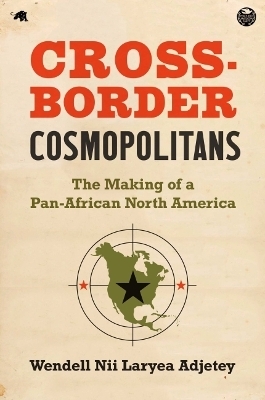
Cross-Border Cosmopolitans
The Making of a Pan-African North America
Seiten
2023
The University of North Carolina Press (Verlag)
978-1-4696-7211-3 (ISBN)
The University of North Carolina Press (Verlag)
978-1-4696-7211-3 (ISBN)
By contending that twentieth-century global Black liberation movements began within the US-Canadian borderlands as cross-border, continental struggles, this book reveals the revolutionary legacies of the Underground Railroad and America’s Great Migration and the hemispheric and transatlantic dimensions of this history.
Twentieth-century African American history cannot be told without accounting for the significant influence of Pan-African thought, just as the story of U.S. policy from 1900 to 2000 cannot be told without accounting for fears of an African World. In the early 1900s, Marcus Garvey and his followers perceived the North American mainland, particularly Canada following U.S. authorities' deportation of Garvey to Jamaica, as a forward-operating base from which to liberate the Black masses. After World War II, Vietnam War resisters, Black Panthers, and Caribbean students joined the throngs of cross-border migrants. In time, as urban uprisings proliferated in northern U.S. cities, the prospect of coalitions among the Black Power, Red Power, and Quebecois Power movements inspired U.S. and Canadian intelligence services to collaborate, infiltrate, and sabotage Black activists and their allies in the United States, Canada, the Caribbean, and southern Africa. Assassinations of "Black messiahs" further radicalized revolutionaries, rekindling the dream for an African World from Washington, D.C., to Toronto to San Francisco to Antigua to Grenada and back to Africa. Alarmed, Washington's national security elites invoked the Cold War as the reason to counter the triangulation of Black Power in the Atlantic World, funneling arms clandestinely from the United States and Canada to the Caribbean and then to its proxies in southern Africa.
By contending that twentieth-century global Black liberation movements began within the U.S.-Canadian borderlands as cross-border, continental struggles, Cross-Border Cosmopolitans reveals the revolutionary legacies of the Underground Railroad and America's Great Migration and the hemispheric and transatlantic dimensions of this history.
Twentieth-century African American history cannot be told without accounting for the significant influence of Pan-African thought, just as the story of U.S. policy from 1900 to 2000 cannot be told without accounting for fears of an African World. In the early 1900s, Marcus Garvey and his followers perceived the North American mainland, particularly Canada following U.S. authorities' deportation of Garvey to Jamaica, as a forward-operating base from which to liberate the Black masses. After World War II, Vietnam War resisters, Black Panthers, and Caribbean students joined the throngs of cross-border migrants. In time, as urban uprisings proliferated in northern U.S. cities, the prospect of coalitions among the Black Power, Red Power, and Quebecois Power movements inspired U.S. and Canadian intelligence services to collaborate, infiltrate, and sabotage Black activists and their allies in the United States, Canada, the Caribbean, and southern Africa. Assassinations of "Black messiahs" further radicalized revolutionaries, rekindling the dream for an African World from Washington, D.C., to Toronto to San Francisco to Antigua to Grenada and back to Africa. Alarmed, Washington's national security elites invoked the Cold War as the reason to counter the triangulation of Black Power in the Atlantic World, funneling arms clandestinely from the United States and Canada to the Caribbean and then to its proxies in southern Africa.
By contending that twentieth-century global Black liberation movements began within the U.S.-Canadian borderlands as cross-border, continental struggles, Cross-Border Cosmopolitans reveals the revolutionary legacies of the Underground Railroad and America's Great Migration and the hemispheric and transatlantic dimensions of this history.
Wendell Nii Laryea Adjetey is assistant professor of post-Reconstruction U.S. and African Diaspora history at McGill University, where he holds the William Dawson Chair. He also goes by Nii Laryea Osabu I, Oblantai Mantse of Atrekor We.
| Erscheinungsdatum | 16.12.2022 |
|---|---|
| Zusatzinfo | 21 halftones, 4 maps, 7 tables |
| Verlagsort | Chapel Hill |
| Sprache | englisch |
| Maße | 155 x 235 mm |
| Gewicht | 363 g |
| Themenwelt | Sachbuch/Ratgeber ► Geschichte / Politik ► Allgemeines / Lexika |
| Geisteswissenschaften ► Geschichte ► Regional- / Ländergeschichte | |
| Sozialwissenschaften ► Ethnologie | |
| Sozialwissenschaften ► Soziologie | |
| ISBN-10 | 1-4696-7211-1 / 1469672111 |
| ISBN-13 | 978-1-4696-7211-3 / 9781469672113 |
| Zustand | Neuware |
| Informationen gemäß Produktsicherheitsverordnung (GPSR) | |
| Haben Sie eine Frage zum Produkt? |
Mehr entdecken
aus dem Bereich
aus dem Bereich
von der Antike bis ins 21. Jahrhundert
Buch | Softcover (2024)
C.H.Beck (Verlag)
CHF 16,80


